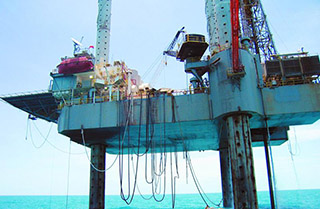(Bloomberg) — The Big Oil earnings season has started with such a surprise that some analysts already say their estimates for the other companies may be too low.
BP Plc and Statoil ASA both reported a first-quarter profit this week after analysts predicted losses, while Total SA beat earnings estimates by 31%. The results, reflecting sweeping cost cuts as well as resilient refining, trading and petrochemical operations, suggest Exxon Mobil Corp. and others may also trump expectations.
“It seems the cost reduction has been implemented better than expected by the companies,” said Alexandre Andlauer, an analyst at AlphaValue SAS in Paris. “It’s now more than probable the others will beat estimates too.”
Oil majors are weathering the crude-market rout by lowering capital expenditure, renegotiating drilling contracts, slashing thousands of jobs and deferring big projects. The pace of such measures is sometimes so steep it isn’t reflected in quarterly earnings forecasts, according to Andlauer.
Belt-tightening at BP includes a delay to approving the Mad Dog Phase 2 project in the Gulf of Mexico as it renegotiates costs to half of the original $20 billion estimate. Capital expenditure may fall to about $17 billion this year from an earlier projection of as much as $19 billion, and could sink to as little as $15 billion next year if oil stays low, the company said Tuesday.
Total also announced a reduction in projected capital spending for this year, while Norway’s Statoil cut operating costs per barrel by a fifth.
Total’s shares rose 2.8% in Paris, Statoil gained 6.1% in Oslo and BP added 1.7% in London Tuesday — all of them advancing to the highest level in more than four months.
Besides cost reductions, the companies’ oil refining, trading and petrochemical businesses surprised analysts. BP and Total are running crude-processing plants hard to maximize revenue while feedstock remains cheap. BP doesn’t plan to cut its run-rate in the near future, according to Chief Financial Officer Brian Gilvary, who also said strong trading boosted downstream profit.
It’s not always easy for analysts to estimate the majors’ trading profits because they don’t disclose those results, said Ahmed Ben Salem, an analyst at Oddo & Cie in Paris. Petrochemical earnings are also a “challenge” to forecast, according to Jason Kenney, an Edinburgh-based analyst at Banco Santander SA.
Downstream Focus
“It is rare to have petchem modeled in any particular detail, product-by-product or region-by-region,” Kenney said by e-mail. “The focus of integrated oil modeling is usually upstream, which normally provides the bulk of earnings.”
Yet with majors such as Total and BP posting losses from exploration and production, or E&P, last year, downstream divisions have come to the fore.
Exxon and Royal Dutch Shell Plc could report stronger-than-expected petrochemical earnings, and “that could drive a beat versus current estimates, if the read-through from Total and BP is anything to go by,” Kenney said.
Estimates for Exxon, due to report April 29, suggest it’ll post its lowest earnings in more than two decades, while Shell is expected to report the smallest profit in at least 10 years on May 4.
Chevron Corp. and Italy’s Eni SpA will also release quarterly results on April 29, while Spain’s Repsol SA will report May 5. They’ve all cut billions of dollars of investments, contributing to the $250 billion reduction in global E&P spending last year, consultants Rystad Energy said in December.
“The majors are doing the job to adjust to lower oil prices,” Oddo’s Ben Salem said. “The question is: if oil goes deeper, is there more room?”




